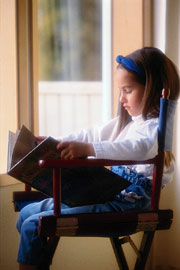|
|
THE 7
VISUAL ABILITIES
 In
our office we, we use Vision Therapy to train seven different visual abilities. In
our office we, we use Vision Therapy to train seven different visual abilities.
The first and best known visual ability
is 20/20 eyesight. If, at twenty feet, you can see the same letters that
people with normal eyes can see at twenty feet, then we say that you have
"20/20 eyesight."
Unfortunately, 20/20 eyesight—with or without new glasses—does
not mean that during reading and desk work you can see clearly for more
than a few minutes. 20/20 eyesight doesn't mean that you have the depth
perception and localization skills to drive at night or that you are free
from vision-caused headaches and general fatigue. All 20/20 eyesight guarantees
is that you can see clearly long enough to call out six letters on a doctor's
eye chart. Therefore, in addition to "20/20 eyesight" we have
to consider 6 other visual abilities that are generally ignored during
routine exams.
The second visual ability is Eye-Muscle
Coordination. We have fourteen eye muscles. The brain must coordinate
these muscles perfectly if we are to see comfortably and efficiently.
If this coordination is difficult, eyesight be clear at the times but
blurred or double at others. The effort to prevent such blurred or double
vision (diplopia) can cause premature fatigue, or loss of attention and comprehension
during reading, desk or computer work. Certain types of eye muscle coordination
problems can reduce depth perception for driving and sports. In extreme
cases, poor eye muscle coordination can even cause crossed or lazy eyes (strabismus or amblyopia).
Eye Control is used for "keeping
our eyes on the ball" or maintaining eye contact during conversations.
When Eye Control is inaccurate, seeing is inaccurate. Our Eye Control
is a direct measure of how vision is affecting our attention.
We use the term Visual Tracking to
describe how quickly and accurately we move our eyes across a line of
print, look at the symbols (such as numbers, letters or words) remember
what to call them, and get the sounds out of our mouths. During reading,
poor Visual Tracking causes loss of place, confusing one word with another,
careless errors, and difficulty breaking words down into their parts.
"Visual Perception" as
the ability to see how things are alike and different, how the pieces
fit together to make up the whole. At one extreme we have the artist who
can look at a scene and "see" the relationships between the
shapes and colors well enough to reproduce them with paint on canvas.
On the other extreme, we have the child who cannot tell the difference
between a "b" and a "d" or a "was" and a
"saw". Visual perception problems can make it difficult to recognize
words, complete puzzles, align columns in math or—for adults—read
a roadmap.
We can divide our ability to get
our eyes to guide our hands into "little" coordination and "big"
coordination. We need "little" coordination to copy sentences
and to keep words equally spaced and on the line. We need "big"
coordination to throw or catch a ball or to guide a steering wheel. The
"big" type of eye-hand coordination is also very much linked
with balance and general coordination.
Visualization is sometimes called,
"seeing with the mind's eye." If visualization is good, a child
or adult can "see" words in the mind to spell them. They can
"see" the story when they are reading. They can picture their
goals in their minds. They have the ability to picture the consequences
of their actions. Visualization allows us to learn from the past and plan
for the future.
|
|
| |
|







